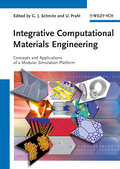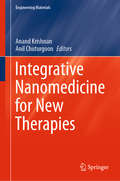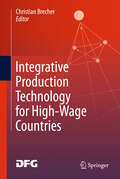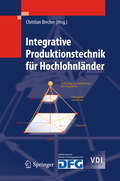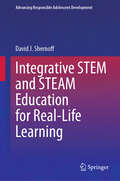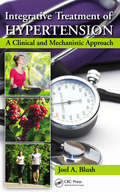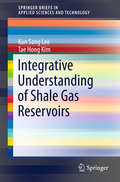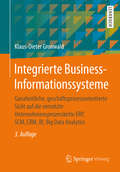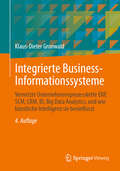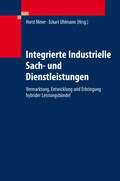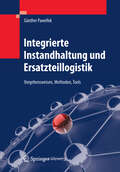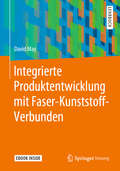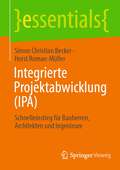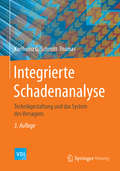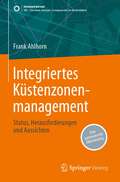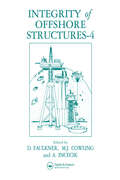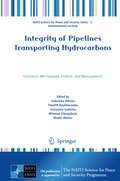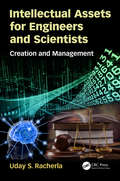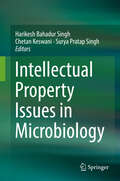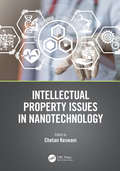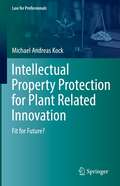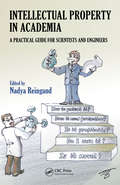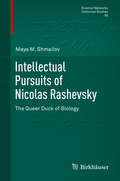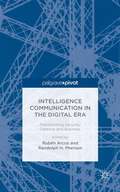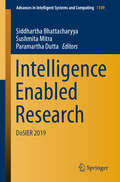- Table View
- List View
Integrative Computational Materials Engineering
by Ulrich Prahl Georg J. SchmitzPresenting the results of an ambitious project, this book summarizes the efforts towards an open, web-based modular and extendable simulation platform for materials engineering that allows simulations bridging several length scales. In so doing, it covers processes along the entire value chain and even describes such different classes of materials as metallic alloys and polymers. It comprehensively describes all structural ideas, the underlying concepts, standard specifications, the verification results obtained for different test cases and additionally how to utilize the platform as a user and how to join it as a provider.A resource for researchers, users and simulation software providers alike, the monograph provides an overview of the current status, serves as a generic manual for prospective users, and offers insights into the inner modular structure of the simulation platform.
Integrative Nanomedicine for New Therapies (Engineering Materials)
by Anil Chuturgoon Anand KrishnanThis book presents current laboratory, scientific and clinical aspects of nanomaterials used for medical applications in the fields of regenerative medicine, dentistry and pharmacy. It gives a broad overview of the in vitro compatibility assessment of nanostructured materials implemented in the medical field by the combination of classical biological protocols. The chapters cover all aspects of integrative medicine, such as green derived nanomaterials for biological applications; synthetic and nature-derived lipid nanoparticles and polymer nanoparticles.
Integrative Production Technology for High-Wage Countries
by Christian BrecherIndustrial production in high-wage countries like Germany is still at risk. Yet, there are many counter-examples in which producing companies dominate their competitors by not only compensating for their specific disadvantages in terms of factor costs (e.g. wages, energy, duties and taxes) but rather by minimising waste using synchronising integrativity as well as by obtaining superior adaptivity on alternating conditions. In order to respond to the issue of economic sustainability of industrial production in high-wage countries, the leading production engineering and material research scientists of RWTH Aachen University together with renowned companies have established the Cluster of Excellence "Integrative Production Technology for High-Wage Countries". This compendium comprises the cluster's scientific results as well as a selection of business and technology cases, in which these results have been successfully implemented into industrial practice in close cooperation with more than 30 companies of the industrial production sector.
Integrative Produktionstechnik für Hochlohnländer
by Christian BrecherAuch wenn die industrielle Fertigung von Produkten in Hochlohnländern wie Deutschland gefährdet ist, gibt es viele Beispiele für Unternehmen, denen es gelingt, durch ihre Produktion den Wettbewerb zu dominieren - u. a. indem sie Verschwendung durch synchronisierende Integrativität minimieren und sich höchst adaptiv verhalten. In dem Buch werden die wissenschaftlichen Ergebnisse des Aachener Exzellenzclusters "Integrative Produktionstechnik für Hochlohnländer" dargestellt und deren erfolgreiche Umsetzung in die industrielle Praxis beschrieben.
Integrative STEM and STEAM Education for Real-Life Learning (Advancing Responsible Adolescent Development)
by David J. ShernoffThis book illustrates that real-life learning in which students conduct scientific investigations and make new innovations to solve real-world problems is an integral part of STEM (science, technology, engineering, math) and STEAM (science, technology, engineering, art, math) education. It provides examples of student and teacher work from projects of the Rutgers University Center of Mathematics, Science, and Computer Education. The book examines how new K to 12 education standards and innovative teacher professional development programs – which emphasize transdisciplinary approaches to STEM and STEAM – lead to the emergence of real-life education in schools. In addition, the book references related research to identify key advances in STEM and STEAM education. Special topics include the uses of makerspaces, educational video games, artificial intelligence (AI), and machine learning to fuel project-based, real-life learning. Key areas of coverage include: the role of new K-12 standards in science, design thinking, computer science, and climate change in stimulating integrative STEM/STEAM education; obstacles and supports for teaching integrative STEM programs; modes of collaboration in STEM, STEAM, and maker-based education; and the importance of teacher professional development to promote transdisciplinary learning. Integrative STEM and STEAM Education for Real-Life Learning is an essential resource for researchers, professors, college students, as well as educational leaders and policy makers with interests in the STEM and STEAM disciplines, psychology, teaching and teacher education, library science, and multimedia. “A must-read for anyone committed to the future of education. This book is not only thought-provoking; it is a guide to action, offering a compelling approach that empowers youth and educators alike.” Dr. Margaret Honey, President and CEO, Scratch Foundation “David J. Shernoff, a leading expert in the field, explores how integrative approaches in STEM and STEAM are not just about preparing students for the future, but engaging them in solving real-world problems today…this book demonstrates how education can empower students to become active, innovative contributors to society.” Cassie Quigley, author of Educator’s Guide to STEAM Education
Integrative Treatment of Hypertension: A Clinical and Mechanistic Approach
by Joel A. BlushGiven current trends toward obesity, sedentary lifestyles, and poor diets, hypertension is increasingly becoming a disease of the young as well as the elderly, affecting about 1 billion people worldwide. Many patients, especially the younger ones, would prefer alternative treatments. While natural remedies have been used for much longer than pharma
Integrative Understanding of Shale Gas Reservoirs
by Kun Sang Lee Tae Hong KimThis timely book begins with an overview of shale gasreservoir features such as natural fracture systems, multi-fractured horizontalwells, adsorption/desorption of methane, and non-linear flow within thereservoir. Geomechanical modelling, an aspect of importance in ultra-lowpermeability reservoirs, is also presented in detail. Taking these complex features of shale reservoirs intoaccount, the authors develop a numerical model, which is verified with fielddata using the history matching technique. Based on this model, the pressuretransient and production characteristics of a fractured horizontal well in ashale gas reservoir are analysed with respect to reservoir and fractureproperties. Methods for the estimation of shale properties are also detailed. Minifrac tests, rate transient tests (RTA), and type curve matching are used toestimate the initial pressure, permeability, and fracture half-length. Lastly,future technologies such as the technique of injecting CO2 into shalereservoirs are presented. The book will be of interest to industrial practitioners, aswell as to academics and graduate students in the field of reservoirengineering.
Integrierte Business-Informationssysteme: Ganzheitliche, geschäftsprozessorientierte Sicht auf die vernetzte Unternehmensprozesskette ERP, SCM, CRM, BI, Big Data Analytics (Examen. Press Ser.)
by Klaus-Dieter GronwaldEnterprise Resource Planning (ERP), Supply Chain Management (SCM), Customer Relationship Management (CRM), Business Intelligence (BI) und Big Data Analytics (BDA) sind unternehmerische Aufgaben und Prozesse, die durch standardisierte Softwarelösungen unterstützt werden.Dieses Lehrbuch lässt Studierende direkt aus der Businessperspektive anhand eines rollenbasierten Business Games erfahren, wie unternehmerische Aufgaben und Prozesse mit Hilfe standardisierter Softwaresysteme realisiert werden. Dadurch vermittelt es managementorientiertes Denken und Handeln, das für Informatiker, die sich mit geschäftsprozessorientierten IT-Lösungen befassen, unerlässlich ist.Die dritte Auflage des Buches wurde vollständig überarbeitet, neu strukturiert und um aktuelle Themenbereiche wie Blockchains in der Supply Chain und die Beziehung von Big Data Analytics zu Artificial Intelligence und Machine Learning ergänzt. Die Struktur des Buches orientiert sich an der schrittweisen Implementierung und Integration der jeweiligen Informationssysteme aus Unternehmens-, Business-, und Managementsicht. Teil I enthält ausführliche Kapitel zu den behandelten Themen mit Online-Tests und -Übungen zu jedem Kapitel. Teil II führt in das Rollenspiel und in die Online-Gaming- und Simulationsumgebung ein. Ergänzendes Unterrichtsmaterial, Präsentationen, Templates und Videoclips stehen online im Gamingbereich zur Verfügung. Die für dieses Buch neu geschaffene Gaming- und Businesssimulation Kdibisglobal.com enthält neben der bisherigen Bier-Division neu eine Mineral- und Tafelwasser-Division, eine Soft-Drink-Division sowie ein Fertigungsunternehmen für Barcode-Kassensysteme mit ihren speziellen Geschäftsprozessen und Supply Chains.
Integrierte Business-Informationssysteme: Vernetzte Unternehmensprozesskette ERP, SCM, CRM, BI, Big Data Analytics, und wie künstliche Intelligenz sie beeinflusst
by Klaus-Dieter GronwaldEnterprise Resource Planning (ERP), Supply Chain Management (SCM), Customer Relationship (CRM), Business Intelligence (BI), und Big Data Analytics sind unternehmerische Aufgaben und Prozesse, die durch standardisierte Softwarelösungen realisiert werden. Methoden der künstlichen Intelligenz wie Machine Learning, generative KI und Computer Vision beeinflussen und steuern diese Prozesse. Dieses Lehrbuch lässt Studierende aus der Businessperspektive erfahren, wie diese Methoden vernetzt sind, wie sie sich gegenseitig beeinflussen und wo ihre Grenzen sind. Dadurch wird managementorientiertes Denken und Handeln vermittelt, das für Informatiker, die sich mit geschäftsprozessorientierten IT-Lösungen befassen, unerlässlich ist.
Integrierte Industrielle Sach- und Dienstleistungen
by Eckart Uhlmann Horst MeierHybride Leistungsbündel (HLB) dienen dazu, ein innovatives und nutzenorientiertes Produktverständnis von Sach- und Dienstleistungen zu etablieren. Hochkomplexe Anlagen lassen sich durch diese integrierte Betrachtung von Sach- und Dienstleistungsanteilen deutlich besser vermarkten. Der Band liefert einen Überblick zu diesem Konzept und stellt entsprechende Methoden und Werkzeuge zur Entwicklung von Sach- und Dienstleistungen vor. Dabei berücksichtigen die Autoren den gesamten Zyklus: von der Planung und Entwicklung bis zur Erbringung und Nutzung.
Integrierte Instandhaltung und Ersatzteillogistik
by Günther PawellekIn dem Leitfaden wird die Analyse- und Entscheidungssystematik zur Gestaltung integrierter Instandhaltung und Ersatzteillogistik beschrieben. Gezeigt wird, wie die Prozesse mit einem integrierten Planungsansatz und neuen Analyse- und Bewertungstools auch langfristig verbessert werden können: durch zielgerichtetes und strukturiertes Vorgehen, die Einbeziehung anlagen- und komponentenspezifischer Aspekte und durch permanentes Monitoring. Das Buch richtet sich an Ingenieure sowie Führungskräfte und Mitarbeiter in Instandhaltung und Ersatzteillogistik.
Integrierte Produktentwicklung mit Faser-Kunststoff-Verbunden
by David MayFaser-Kunststoff-Verbunde (FKV) bieten herausragende Vorteile, von denen das hohe Leichtbaupotenzial der wohl markanteste, aber bei weitem nicht der einzige ist. Für eine effiziente und erfolgreiche Produktentwicklung mit FKV, die diese Vorteile ausschöpft, ist dabei eine integrierte Produktentwicklung erforderlich. Dieses Buch vermittelt die hierfür notwendigen Grundlagen. Einleitend werden die materialspezifischen Vorteile von FKV und daraus abgeleitet die typischen Anwendungsgebiete vorgestellt. Anschließend wird aufgezeigt, welche Probleme eine konventionelle, nicht integrierende Produktentwicklung erzeugt, und wie diese durch ein integrierte Produktentwicklung (IPE) überwunden werden. Zudem wird erläutert wieso IPE gerade für FKV von Bedeutung ist. Im Hauptteil des Buches wird zunächst ein Ansatz zur IPE von FKV-Bauteilen vorgestellt. Der weitere Aufbau des Buches entspricht dieser Vorgehensweise und erklärt Schritt für Schritt, wie zunächst ein Anforderungskatalog erstellt und darauf basierend, ein Konzept, ein Entwurf und schließlich eine ausgearbeitete Konstruktion entstehen. Dabei werden auch einfache, aber effektive Methoden für die Auswahl von Fasermaterialien, Halbzeugen und Fertigungsverfahren definiert. Deren Anwendung erlaubt es, bereits in einem frühen Stadium des Entwicklungsprozesses grundlegende Entscheidungen zu treffen, die als Basis für die Entwicklungen in den verschiedenen Bereichen dienen. So wird eine effiziente, simultane Entwicklung konstruktiver, fertigungstechnischer und werkstofflicher Aspekte ermöglicht. Ein abschließendes Kapitel beschreibt einen Ansatz zur technoökonomischen Bewertung, mit dem eine finale Entscheidung zwischen verschiedenen Alternativen getroffen werden kann. Anhand praxisnaher Anwendungsbeispiele wird den Lesern aufgezeigt, wie das erlangte Wissen in der Praxis umgesetzt werden kann.
Integrierte Projektabwicklung: Schnelleinstieg für Bauherren, Architekten und Ingenieure (essentials)
by Simon Christian Becker Horst Roman-MüllerDie Integrierte Projektabwicklung (IPA) ist ein neues Verfahren, um insbesondere große komplexe Bauprojekte erfolgreich umzusetzen. In Deutschland noch wenig bekannt, beginnt es sich auch hier zu etablieren. Dieser Schnelleinstieg stellt die IPA und ihren innovativen Denkansatz vor. Dazu gehören eine frühzeitige Einbindung aller wesentlichen Beteiligten, das Prinzip der Einstimmigkeit sowie eine von Respekt und Vertrauen geprägte Projektkultur. Ein neues Vergütungsmodell liefert zusätzlich Anreize zur Kooperation mit dem Ziel, gemeinsam das Beste für das Bauprojekt zu erreichen.
Integrierte Schadenanalyse: Technikgestaltung und das System des Versagens (VDI-Buch)
by Karlheinz G. Schmitt-ThomasDieses Buch behandelt die systematische und nachvollziehbare Klärung der Ursachen und der Ereignisabfolgen bei technischen Versagensabläufen, Schäden und Schwachstellen, ausgehend von werkstoffkundlichen Untersuchungen. Es bietet für den Gutachter wie für den planenden Ingenieur Grundlagen, um große wirtschaftliche Schäden und Katastrophen vermeiden zu können.Die Schadenanalyse wird nach einer speziellen Systematik unter Beachtung von Ereignisketten an Beispielen und in Fallstudien dargestellt. Möglichkeiten und Grenzen verschiedener Untersuchungsverfahren werden aufgezeigt. Das Buch bietet zudem eine schlüssige Darstellung der systematischen Schaden- und Schwachstellenanalyse. Vorgehensweisen, Untersuchungsmethoden und Schadenbeispiele werden in eine strenge Systematik eingeordnet.
Integriertes Küstenzonenmanagement: Status, Herausforderungen und Aussichten (SDG - Forschung, Konzepte, Lösungsansätze zur Nachhaltigkeit)
by Frank AhlhornDieses Buch gibt einen kurzen, aber umfassenden Überblick über das Integrierte Küstenzonenmanagement. Am Beispiel der Wasserwirtschaft ermöglicht es dem Leser, die unterschiedlichen Interessen und Anforderungen zu verstehen. Es ist als Lehrbuch für Studenten gedacht, kann aber auch von Fachleuten in der Verwaltung sowie im Projektmanagement und in der Planung verwendet werden. Durch die Zusammenfassung hydrologischer Aspekte verdeutlicht es die Herausforderungen im Wassermanagement (z. B. Küstenschutz, Entwässerung und Flussmanagement). Außerdem werden die Grundsätze und Methoden für Integration und gute, kooperative Prozesse unter Berücksichtigung der Interessen und Anforderungen in den Küstengebieten vorgestellt. Das Buch konzentriert sich auf den Status quo in Europa, mit Beispielen aus den Niederlanden, Deutschland und Spanien, und bietet aktuelle Einblicke in die Vereinigten Staaten von Amerika oder Australien. Der Autor erweitert den Blick durch kurze Behandlung zusätzlicher Themen, wie die Einbeziehung historischer Betrachtungen.
Integrity of Offshore Structures
by D. FaulknerPapers presented at the Fourth International Symposium on Integrity of Offshore Structures, 2-3 July 1990, Kelvin Conference Centre, University of Glasgow, Scotland organized by the Department of Naval Architecture and Ocean Engineering and Mechanical Engineering.
Integrity of Pipelines Transporting Hydrocarbons
by Giovanna Gabetta Mekki Mellas Taoufik Boukharouba Gabriella Bolzon Mimoun ElboujdainiThis book describes technical and practical aspects of pipeline damage. It summarizes the phenomena, mechanisms and management of pipeline corrosion in-service. The topics discussed include pipelines fracture mechanics, damage mechanisms and evolution, and pipeline integrity assessment. The concept of acceptable risk is also elucidated and the future application of new knowledge management tools is considered.
Intellectual Assets for Engineers and Scientists: Creation and Management
by Uday S. RacherlaEngineers and scientists engaged in creative works, inventions, and innovations – as part of the free-enterprise, free-market system – must understand what Intellectual Property Rights (IPRs) are and know how to strategically use them to create competitive advantage, wealth, and value. An acknowledged, major contributing factor to non-awareness amongst technical audience is the lack of availability of easily-understandable, business-relevant, and comprehensive books on the subject, that scientists and engineers can access. This book will provide comprehensive, easy-to-understand, innovation management perspectives on a wide range of IPRs for practicing scientists and engineers. Key Features: • One-stop shop for valuable information on all forms of IPRs for technical audience • Strong innovation management component along the lines of technology for business and innovations for customers, and IP laws for protecting and unlocking the value of creative works, inventions, and innovations • Gives easy-to-read, easy-to-follow innovation management perspectives • Emphasizes IPR-related topics of practical relevance • Compares the IP Systems of United States and others (EU, China & India)
Intellectual Property Issues in Microbiology
by Harikesh Bahadur Singh Chetan Keswani Surya Pratap SinghIn the current era current era of significant innovations, science and technology are powerful tools improving human welfare through prosperity and sustainable development. The development of microbiology based industries in any given country is shaped by the characteristics of its technology—particularly its close relation to scientific knowledge, and by country-specific factors such as the level and nature of the scientific knowledge base, the institutional set-up, and the role assumed by the government, all of which influence the country's ability to exploit the new opportunities.This unique book presents an integrated approach for sustained innovation in various areas of microbiology. Focusing on the industrial and socio-legal implications of IPR in microbiological advances, it offers a comprehensive overview not only of the implications of IPR in omics-based research but also of the ethical and intellectual standards and how these can be developed for sustained innovation.The book is divided into three sections discussing current advances in microbiological innovations, recent intellectual property issues in agricultural, and pharmaceutical microbiology respectively. Integrating science and business, it offers a glimpse behind the scenes of the microbiology industry, and provides a detailed analysis of the foundations of the present day industry for students and professionals alike.
Intellectual Property Issues in Nanotechnology
by Chetan KeswaniIntellectual Property Issues in Nanotechnology focuses on the integrated approach for sustained innovation in various areas of nanotechnology. The theme of this book draws to a great extent on the industrial and socio-legal implications of intellectual property rights for nanotechnology-based advances. The book takes a comprehensive look not only at the role of intellectual property rights in omics-based research but also at the ethical and intellectual standards and how these can be developed for sustained innovation. This book attempts to collate and organize information on current attitudes and policies in several emerging areas of nanotechnology. Adopting a unique approach, this book integrates science and business for an inside view of the industry. Peering behind the scenes, it provides a thorough analysis of the foundations of the present day industry for students and professionals alike.
Intellectual Property Protection for Plant Related Innovation: Fit for Future? (Law for Professionals)
by Michael Andreas KockThe book reviews the history, present, and likely future of intellectual property for plant-related inventions. It describes “what works” and “what does not work” in the current situation and analyzes whether the current intellectual property framework will be able to cope with the rise of genome editing/new breeding technologies (especially CRISPR Cas). Based on trend data, the analysis shows that the current system, including stakeholder initiatives, will most likely not be able to adapt to the technology change. It then evaluates different options for legislators to respond and proposes in detail a new holistic IP system which merges elements of the patent and the plant variety protection system into one new system.
Intellectual Property in Academia: A Practical Guide for Scientists and Engineers
by Nadya ReingandThis book provides a practical understanding of intellectual property basics relevant in an academic environment. It describes the process of performing a comprehensive prior art search, determining business value, filing for a patent, licensing to companies, and using follow-up patents to create a valuable portfolio. The text also covers starting a new business and recent changes in patent application procedures. A special chapter addresses issues in copyright law relevant to academics, such as determining what is copyrightable in reporting an industry-sponsored project.
Intellectual Pursuits of Nicolas Rashevsky
by Maya M. ShmailovWho was Nicolas Rashevsky? To answer that question, this book draws on Rashevsky's unexplored personal archival papers and shares interviews with his family, students and friends, as well as discussions with biologists and mathematical biologists, to flesh out and complete the picture. "Most modern-day biologists have never heard of Rashevsky. Why?" In what constitutes the first detailed biography of theoretical physicist Nicolas Rashevsky (1899-1972), spanning key aspects of his long scientific career, the book captures Rashevsky's ways of thinking about the place mathematical biology should have in biology and his personal struggle for the acceptance of his views. It brings to light the tension between mathematicians, theoretical physicists and biologists when it comes to the introduction of physico-mathematical tools into biology. Rashevsky's successes and failures in his efforts to establish mathematical biology as a subfield of biology provide an important test case for understanding the role of theory (in particular mathematics) in understanding the natural world. With the biological sciences moving towards new vistas of inter- and multi-disciplinary collaborations and research programs, the book will appeal to a wide readership ranging from historians, sociologists, and ethnographers of American science and culture to students and general readers with an interest in the history of the life sciences, mathematical biology and the social construction of science.
Intelligence Communication in the Digital Era: Transforming Security, Defence and Business
by Randolph H. Pherson Rubén ArcosThis edited volume argues that producers of analysis need to shift from producing static, narrative products to much more dynamic, digitally-based platforms in order to remain competitive and relevant.
Intelligence Enabled Research: DoSIER 2019 (Advances in Intelligent Systems and Computing #1109)
by Siddhartha Bhattacharyya Paramartha Dutta Sushmita MitraThis book gathers extended versions of papers presented at DoSIER 2019 (the First Doctoral Symposium on Intelligence Enabled Research, organized by RCC Institute of Information Technology, Kolkata, India). The papers address the rapidly expanding research area of computational intelligence, which, no longer limited to specific computational fields, has since made inroads in signal processing, smart manufacturing, predictive control, robot navigation, smart cities, and sensor design, to name but a few. Presenting chapters written by experts active in these areas, the book offers a valuable reference guide for researchers and industrial practitioners alike, and will inspire future studies.
